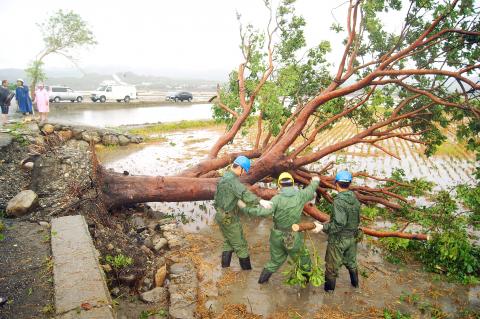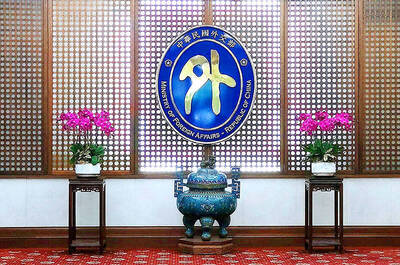What is arguably the most famous tree at Taiwan’s east coast region was uprooted during Typhoon Matmo’s onslaught on Tuesday evening, leaving the local government and residents at odds over its fate.
Standing alone next to a road between rice paddies and farmlands against a backdrop of green mountains in Taitung County’s Chihshang Township (池上), the red cedar has become a popular tourist attraction after being featured in EVA Air’s “I See You” international advertising campaign since last year.
The television ad shows Taiwanese-Japanese actor Takeshi Kaneshiro (Jin Cheng-wu, 金城武) riding a bicycle along the rural road and stopping in the shade of the tree to drink a cup of tea.

Photo: Wang Hsiu-ting, Taipei Times
The advertisement resulted in visitors flocking to the site’s postcard-perfect surroundings to take photographs with the tree, which has become known as the “Takeshi Kaneshiro tree.”
Yesterday morning, after Typhoon Matmo pummeled the east coast, a local resident found the tree uprooted and lying in a rice paddy.
Some local residents said they are saddened by the tree’s demise, with the Chihshang Township Council and the Taitung County Government vowing to save the tree by replanting it in its original position.

Photo: Wang Hsiu-ting, Taipei Times
However, another group of local residents has voiced their objections, saying that the “Takeshi Kaneshiro tree” should not be saved, because it had caused them many headaches and problems.
The objecting group said that the large daily influx of tourists who visit the site to take photographs with the tree has been detrimental to their small village because it creates traffic congestion, air and noise pollution, and trash that has to be cleaned up, all of which create a financial burden.
“I don’t want to see that tree replanted. Us farmers around here do not want all these tourists bringing all sorts of problems with them,” a local farmer said.
He added that only the government and some businesses reaped the benefits of increased tourism, while the farmers suffered most from having to deal with the crowds of tourists and received no benefits at all.
A Taiwan Tree Protection Alliance (台灣護樹團體聯盟) spokesperson, identified only as “Angela,” said the typhoon was the final straw in the demise of the tree, as the alliance had last year already warned that the “Takeshi Kaneshiro tree” was being abused and maltreated.
“[The base of] this famous tree was surrounded and covered by asphalt, which gets very hot in the sun, and its roots were in bad condition due to the asphalt preventing the circulation of air and water. Many cars and tourists [visiting the site] also played a role in destroying the tree’s surrounding habitat,” Angela said yesterday.
Government officials insisted that they plan to replant the tree, but with local residents and environmental groups opposing such a move, a battle between tourism and economic development versus farmers and the need to protect nature is sure to follow.

The Ministry of Foreign Affairs (MOFA) yesterday voiced dissatisfaction with the Comprehensive and Progressive Agreement for Trans- Pacific Partnership (CPTPP), whose latest meeting, concluded earlier the same day, appeared not to address the country’s application. In a statement, MOFA said the CPTPP commission had "once again failed to fairly process Taiwan’s application," attributing the inaction to the bloc’s "succumbing to political pressure," without elaborating. Taiwan submitted its CPTPP application under the name "Separate Customs Territory of Taiwan, Penghu, Kinmen and Matsu" on Sept. 22, 2021 -- less than a week after China

THE GOOD WORD: More than 100 colleges on both sides of the Pacific will work together to bring students to Taiwan so they can learn Mandarin where it is spoken A total of 102 universities from Taiwan and the US are collaborating in a push to promote Taiwan as the first-choice place to learn Mandarin, with seven Mandarin learning centers stood up in the US to train and support teachers, the Foundation for International Cooperation in Higher Education of Taiwan (FICHET) said. At the annual convention of the American Council on the Teaching of Foreign Languages held over the weekend in New Orleans, Louisiana, a Taiwan Pavilion was jointly run by 17 representative teams from the FICHET, the Overseas Community Affairs Council, the Steering Committee for the Test of Proficiency-Huayu, the

A home-style restaurant opened by a Taiwanese woman in Quezon City in Metro Manila has been featured in the first-ever Michelin Guide honoring exceptional restaurants in the Philippines. The restaurant, Fong Wei Wu (豐味屋), was one of 74 eateries to receive a “Michelin Selected” honor in the guide, while one restaurant received two Michelin stars, eight received one star and 25 were awarded a “Bib Gourmand.” The guide, which was limited to restaurants in Metro Manila and Cebu, was published on Oct. 30. In an interview, Feng Wei Wu’s owner and chef, Linda, said that as a restaurateur in her 60s, receiving an

MORE RETALIATION: China would adopt a long-term pressure strategy to prevent other countries or future prime ministers following in Sanae Takaichi’s steps, an academic said Taiwan should maintain communications with Japan, as Japanese Prime Minister Sanae Takaichi is to lead a revision of security documents, Taiwanese academics said yesterday. Tensions have risen between Japan and China over remarks by Takaichi earlier this month that the use of force against Taiwan would constitute a “survival-threatening situation” for Japan. Prospect Foundation president Lai I-chung (賴怡忠) yesterday said Takaichi’s stance regarding Taiwan is the same as past Japanese prime ministers, but her position is clearer than that of her predecessors Fumio Kishida and Shigeru Ishiba. Although Japan views a “Taiwan contingency” as a “survival-threatening situation,” which would allow its military to